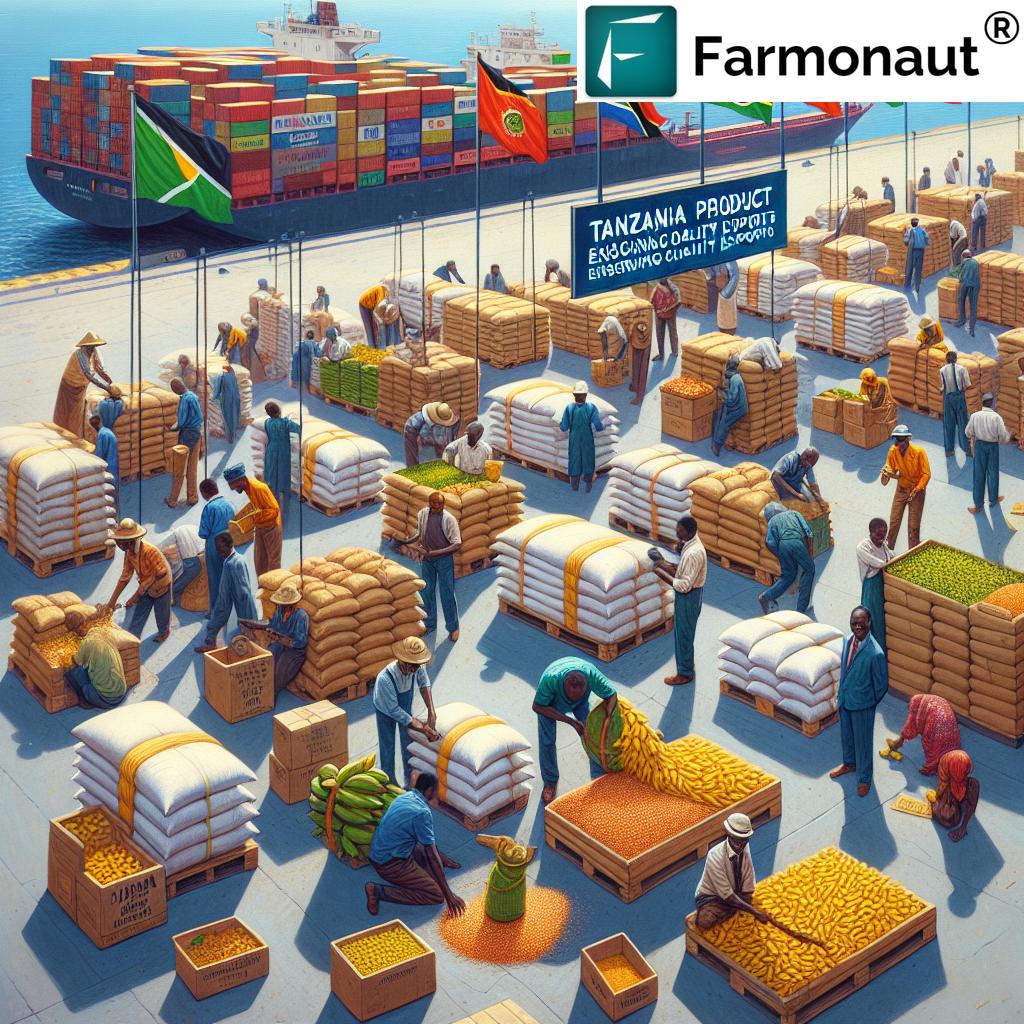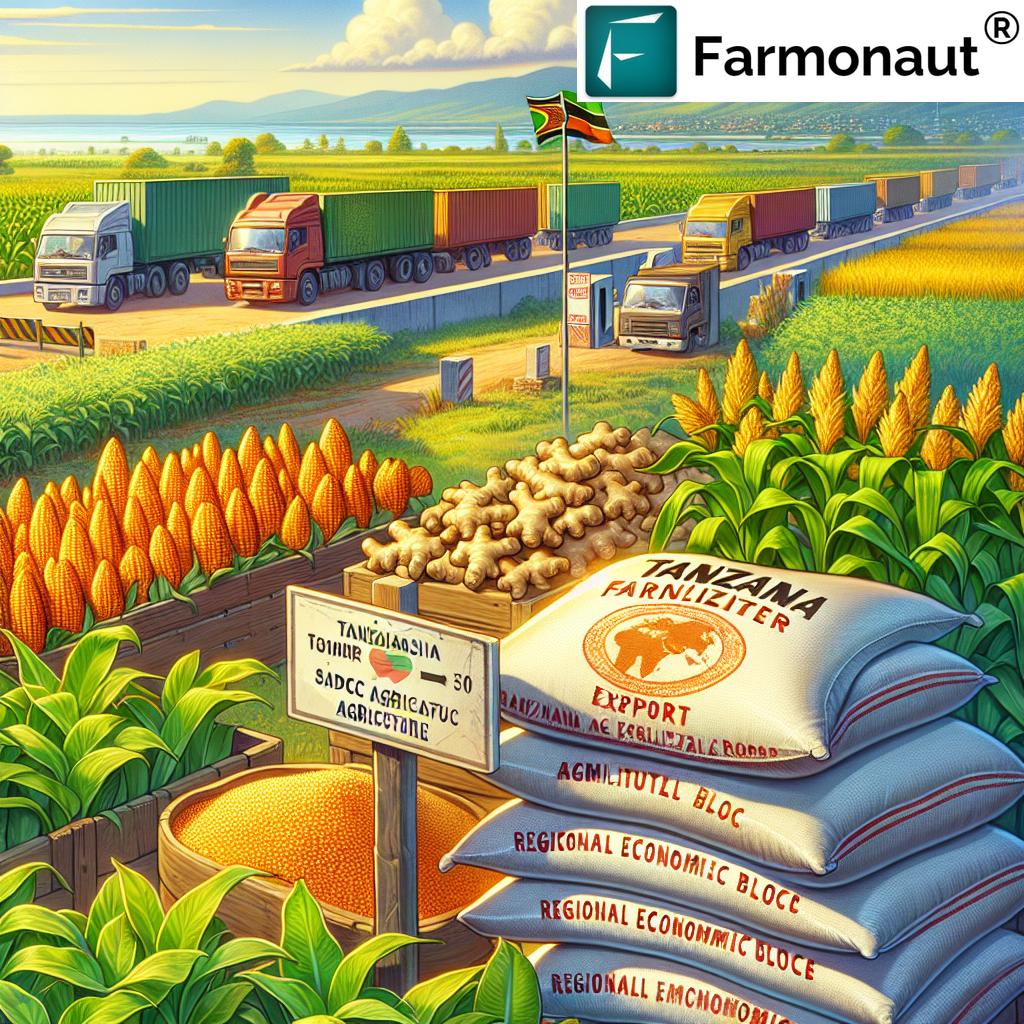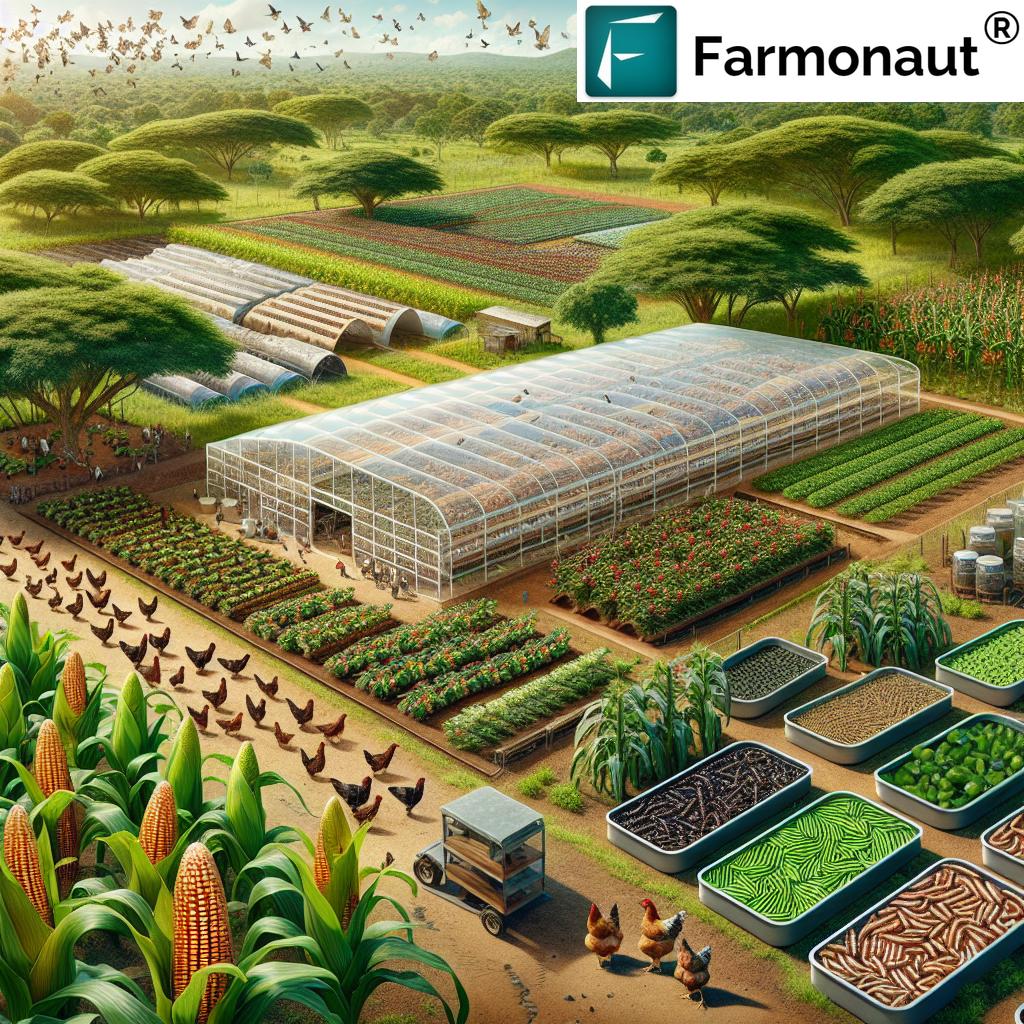Tanzania Agricultural Exports: Key Changes Impacting SADC Trade
“Tanzania lifted import bans on Malawi and South Africa in 2024, reshaping SADC agricultural trade flows.”
Table of Contents
- Tanzania, Malawi, South Africa: The SADC Trade Policy Context
- The Ban on Agricultural Imports: Tanzania’s Recent Policy Fluctuations
- Analysis of Tanzania Agricultural Exports in Africa’s Regional Economy
- Key Crops & Commodities: Maize, Rice, Bananas, & More
- Comparative Trade Impact Table: Tanzania, Malawi, and South Africa
- SADC Agricultural Commodities: A Changing Landscape
- Adapting to Policy Change: Precision Agriculture & Farmonaut Solutions
- Regulatory Framework: Plant Health & Pesticides Authority (TPHPA)
- Tanzania Fertilizer Export Reforms
- Dar es Salaam Agricultural News & Industry Trends
- Farmonaut Pricing & Subscription Options
- Farmonaut App Access & API Integration
- Frequently Asked Questions
Tanzania, Malawi, South Africa: The SADC Trade Policy Context
Tanzania’s strategic position within the Southern African Development Community (SADC) makes it an essential player in Africa’s agricultural export landscape. In 2024, headline-making moves in trade policy, especially tanzania’s lifting of agricultural import bans on Malawi and South Africa, have fundamentally shifted the balance and flow of SADC agricultural commodities. As members of the regional economic bloc SADC, these african countries cooperate to boost intra-regional trade, food security, and economic integration.
However, recent months saw a trade dispute spiral into a temporary but high-impact freeze on agricultural imports and fertilizer exports. For context, Malawi’s ministry of agriculture first banned imports of several tanzanian commodities, including maize flour, rice, ginger, and bananas. South Africa, a key player in african agriculture, stopped imports of bananas from Tanzania. These measures prompted Dar es Salaam’s swift retaliation—cutting off all agricultural produce from Malawi and South Africa, along with a ban on Tanzania fertilizer export to Malawi.
While this standoff was short-lived (with bans swiftly lifted following ministerial diplomacy), the ramifications on Tanzania agricultural exports and Malawi agriculture trade were significant. Understanding these changes is vital for tracking SADC trade trends, plant health authority dynamics, and the evolving agricultural opportunities in Africa.
The Ban on Agricultural Imports: Tanzania’s Recent Policy Fluctuations
The ban on agricultural imports Tanzania enforced in April 2024 was a decisive response to import restrictions imposed by key neighbors Malawi and South Africa. The move sparked immediate ripples through Dar es Salaam agricultural news portals, signaling an African agriculture trade dispute with direct implications for the millions whose livelihoods depend on cross-border flows of food and agri-inputs.
Timeline of the Tanzania-Malawi-South Africa Trade Dispute
- Early April 2024: Malawi bans imports of Tanzanian agricultural commodities like maize flour, rice, ginger, bananas.
- Mid-April 2024: South Africa halts the entry of Tanzania-grown bananas.
- April 24, 2024: Tanzania’s ministry of agriculture retaliates, banning all agricultural imports from both countries and suspending fertilizer exports to Malawi.
- April 26, 2024: Under diplomatic pressure for a SADC ministerial dialogue, Tanzania immediately lifts both bans, as announced by the Tanzania Plant Health and Pesticides Authority (TPHPA), led by Director General Joseph Ndunguru.
These developments underscore the interconnectedness of African agricultural economies, where policy shifts ripple across borders, affecting availability, prices, and trade balances.
Analysis of Tanzania Agricultural Exports in Africa’s Regional Economy
With Tanzania agricultural exports ranking among Africa’s most dynamic, recent policy swings have sent farmers, exporters, and policy analysts scrambling for insight. In 2024, agriculture accounted for about 30% of Tanzania’s GDP, providing a vital livelihood for over 70% of the nation’s workforce.
Why Tanzania’s Agricultural Trade Matters
- Strategic Location: Bordered by eight countries, Tanzania acts as an agricultural gateway to East African and SADC markets.
- Diversity of Products: Major export commodities include maize, rice, bananas, ginger, tobacco, sunflowers, and soya beans.
- Food Security: Regional flows of food and agri-inputs, including fertilizer and seeds, are critical for SADC-wide food security.
- Fertilizer Linkages: With abundant fertilizer production, Tanzania is a valued supplier to neighboring Malawi and others, supporting regional productivity.
When import and export bans are imposed, we not only see a shortfall in direct trade volumes but also cascading effects on prices, farm returns, and supply chains across the SADC region.
“Over 15% of Tanzania’s agricultural exports are now influenced by new trade policies with SADC neighbors.”
Key Crops & Commodities: Maize, Rice, Bananas, & More
In understanding SADC agricultural commodities and Tanzania agricultural exports, it’s crucial to catalog the main crops and exported products:
- Maize Flour & Grains: The staple for much of the SADC region, maize is Tanzania’s leading export crop, flowing to Malawi, South Africa, and beyond.
- Rice: Tanzania stands out for its aromatic rice, feeding domestic and regional demand alike.
- Bananas: A major cash crop, with significant trade volumes previously destined for South Africa.
- Ginger: A valued spice in growing regional and international markets.
- Tobacco, Soya, Sunflowers: Other products vital to export earnings, feeding African manufacturing supply chains.
How did the temporary bans and their lifting impact these product flows? The answer lies in export volumes, prices, and the agility of traders and farmers to respond to policy changes.
Comparative Trade Impact Table: Tanzania, Malawi, and South Africa
To capture the quantitative impact of recent trade policies on Tanzania agricultural exports, we’ve compiled a “Comparative Trade Impact Table.” This side-by-side summary highlights major changes for key crops—before and after the import ban was lifted:
| Agricultural Product | Export Destination | Export Status | Estimated Export Value (USD, millions) | Change (%) |
|---|---|---|---|---|
| Maize (Flour, Grains) | Malawi | Before Ban Lift: Suspended After Ban Lift: Fully Restored |
Before: 70 After: 90 |
+28% |
| Rice | Malawi | Before Ban Lift: Suspended After Ban Lift: Fully Restored |
Before: 25 After: 32 |
+28% |
| Bananas | South Africa | Before Ban Lift: Suspended After Ban Lift: Partially Restored |
Before: 15 After: 19 |
+27% |
| Ginger | Malawi | Before Ban Lift: Suspended After Ban Lift: Fully Restored |
Before: 2 After: 2.4 |
+20% |
| Tobacco | South Africa | Before Ban Lift: Limited After Ban Lift: Fully Restored |
Before: 19 After: 21 |
+10% |
| Soya Beans | Malawi | Before Ban Lift: Limited After Ban Lift: Fully Restored |
Before: 4 After: 5 |
+25% |
| Sunflowers | South Africa | Before Ban Lift: Limited After Ban Lift: Fully Restored |
Before: 6 After: 7.2 |
+20% |
| Fertilizer | Malawi | Before Ban Lift: Blocked After Ban Lift: Restored |
Before: 8 After: 10 |
+25% |
*Figures represent estimates based on available trade data, 2023–2024, and visible market trends after the restoration of trade flows.
SADC Agricultural Commodities: A Changing Landscape
Our analysis reveals that policy volatility can rapidly influence SADC agricultural commodities. For Tanzania, re-opening the borders has not only restored volumes but also reinvigorated regional trust. The quick normalization prevented deep disruption to regional food security, stabilizing access to maize, rice, and critical agri-products.
Shifts in Regional Development Community Trade
- Price Stabilization: After the bans, volatility in staple food prices quickly abated, benefiting both importers and consumers in Malawi and South Africa.
- Expanded Opportunities: With new trade policies, over 15% of Tanzania’s agricultural exports are directly shaped by SADC policy changes (primary focus keyword: Tanzania agricultural exports).
- Increased Diplomacy: Ministerial dialogue, as led by the Tanzania Plant Health and Pesticides Authority, is now central to smoothing future trade issues instead of rapid retaliatory measures.
Adapting to Policy Change: Precision Agriculture & Farmonaut Solutions
Moving forward, the lessons from this African agriculture trade dispute highlight the necessity for resilient, data-driven, and responsive farm management. Technology—particularly satellite-based solutions—are now vital in helping farmers, agribusinesses, and exporters navigate these unpredictable trade environments.
Farmonaut: Empowering African Agriculture
- Satellite Crop Health Monitoring: Farmonaut’s satellite-driven system delivers real-time NDVI, soil moisture, and crop vigor analytics directly to farmers’ mobile devices. This enables optimized irrigation, fertilization, and pest management decisions, tailored to each field’s unique conditions. Read more about carbon footprint tracking solutions—Farmonaut’s tools help monitor and reduce the environmental impact of agricultural operations in Tanzania and the SADC region.
- AI-Based Jeevn Advisory: The Jeevn AI module processes live satellite images and environmental data to provide hyper-personalized farm recommendations—helping growers across Africa respond to rapid changes in trade, prices, and weather.
- Blockchain Traceability: In an age of regulatory scrutiny, product traceability is a must for exporters. Farmonaut’s blockchain-based system assures transparent, tamper-proof records—boosting trust from Tanzanian field to South African supermarket.
- Fleet and Resource Management: Large growers and agri-logistics operators benefit from Fleet Management Solutions for reduced wastage, improved safety, and optimized vehicle usage.
- Crop Loan & Insurance Verification: By enabling banks and insurers to validate crop status via satellite, farmers gain improved access to loans and risk protection. Explore satellite crop loan and insurance for further details.
- Scalable Large-Scale Farm Monitoring: From smallholder plots to vast plantations, Farmonaut’s platform supports large scale farm management for governments and agribusinesses.
Regulatory Framework: Tanzania Plant Health & Pesticides Authority (TPHPA)
Policy and trade in agricultural commodities within SADC are closely monitored and enforced by regulatory authorities. For Tanzania, the Tanzania Plant Health and Pesticides Authority (TPHPA) plays a central role. As articulated by Director General Joseph Ndunguru, TPHPAs mandate spans:
- Approval and inspection of cross-boundary trade in plant products.
- Fertilizer export certifications, especially for regional trade like Tanzania fertilizer export to Malawi.
- Convening ministerial-level talks, promoting dialogue as a preferred mechanism over retaliatory bans.
- Enforcement of SADC development community standards for plant health and phytosanitary compliance.
For farmers and exporters, staying current with Tanzania plant health authority directives is now more essential than ever.
Tanzania Fertilizer Export Reforms: What’s New?
Fertilizer plays a pivotal role in tanzania’s agricultural productivity, particularly for staple crops like maize, rice, and soya. During the brief 2024 trade standoff, Tanzania fertilizer export to Malawi was blocked, interrupting sowing season plans for farmers across the region.
- Restored Trade Flow: The lifting of export bans swiftly normalized fertilizer availability, allowing seasonal planting to proceed on schedule.
- Regional Benefits: Stable exports have reinforced SADC’s goal of mutual food security and sustained agricultural development.
- Innovation in Tracking: Technological tools like Farmonaut tools offer blockchain traceability, tracking fertilizer origin and usage—vital for regulatory compliance and confidence in international markets.
Dar es Salaam Agricultural News & Industry Trends
The rapid developments in Dar es Salaam agricultural news mirror the agility demanded of Tanzanian, Malawian, and South African agri-businesses. Key takeaways from recent reporting include:
- The importance of proactive ministerial communication to prevent escalation of African agriculture trade disputes.
- Recognition that over 15% of Tanzania agricultural exports are shaped by near-term SADC policy changes; quick diplomatic action can stabilize entire supply chains.
- Accelerating adoption of mobile, web, and API-powered farm management solutions like Farmonaut across the region for drought/flood prediction, resource allocation, and regulatory compliance.
Farmonaut Pricing & Subscription Options
To serve the needs of Africa’s rapidly evolving agriculture value chains, Farmonaut offers flexible, subscription-based pricing plans for individual farmers, cooperatives, agribusinesses, government bodies, and NGOs.
- Pick a subscription based on hectares monitored and satellite image frequency.
- Access all features via Android, iOS, and web browser apps, with dedicated API access for seamless integration.
- All subscription options are designed to maximize cost-effectiveness and value for smallholder and commercial farmers alike.
Farmonaut App Access, API Integration, and More
We believe in democratizing access to real-time, affordable precision farming solutions for Tanzanian growers and the whole SADC region. Here’s how to get started:
-
Access Farmonaut on any device:



- API Integration: For developers, agritech businesses, and researchers—integrate Farmonaut’s satellite and weather data directly into your systems for deeper analytics and process automation. Try our API. Full dev documentation is provided here.
- Fleet and Resource Management: Streamline harvest, planting, and transport operations with Farmonaut’s robust fleet tools.
- Product Traceability: Ensure end-to-end supply chain transparency by leveraging Farmonaut’s blockchain traceability platform.
- Large Scale Farm Management: Learn more about end-to-end estate and plantation oversight via our dedicated solution.
Frequently Asked Questions (FAQ)
How did the Tanzania ban on agricultural imports impact SADC trade in 2024?
The brief 2024 import and export bans disrupted Tanzania agricultural exports of maize, rice, bananas, ginger, and other commodities to Malawi and South Africa. This caused temporary supply shortages, price volatility, and economic losses before normal trade resumed after diplomatic intervention.
What role does the Tanzania Plant Health and Pesticides Authority (TPHPA) play?
The Tanzania plant health authority (TPHPA) is responsible for agricultural trade regulation, plant health inspection, fertilizer export oversight, and facilitating dialogue with SADC partners. It helps enforce standards for disease, contamination, and overall product safety in export flows.
Which are Tanzania’s main agricultural export commodities to SADC countries?
Main exports include maize (flour and grain), rice, bananas, ginger, tobacco, soya, and sunflowers. Fertilizer is another critical export—particularly to Malawi.
Why is Farmonaut well-suited for Tanzanian and SADC-region farmers?
With real-time satellite analytics, AI-powered crop advisory, blockchain-based traceability, and flexible, affordable subscription plans, Farmonaut helps African farmers optimize yields, comply with regulatory requirements, and build supply chain trust amid policy changes.
How can I get started with Farmonaut?
Access Farmonaut on web, Android, or iOS. Explore APIs here and documentation here.
Conclusion: Navigating Uncertainty with Technology & Informed Trade
The dramatic trade developments of 2024 underscore the importance of regional cooperation, real-time data, and agile farm management in Tanzanian, Malawian, and South African agricultural economies. With SADC countries relying increasingly on each other for food security, every regulatory action has broad-reaching effects—from plant health to market prices, and regional stability.
Solutions like Farmonaut and robust regulatory frameworks such as the Tanzania Plant Health and Pesticides Authority will shape the future of cross-border commodity flows. As agriculture in Africa modernizes, our collective resilience hinges on leveraging advanced technology, open channels of communication, and an unwavering commitment to the farmers who form the foundation of the continent’s food systems.
To stay ahead of evolving policy and market dynamics, we encourage all stakeholders to embrace digital tools, monitor industry news, and advocate for fair, transparent trade across the Southern African Development Community.
Ready to optimize your regional agricultural operations? Start now with Farmonaut’s farm management platform for a more connected, transparent, and sustainable future.
















